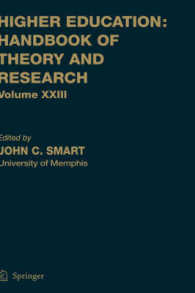- ホーム
- > 洋書
- > 英文書
- > Science / Mathematics
Full Description
In areas such as military, security, aerospace, and disaster management, the need for performance optimization and interoperability among heterogeneous systems is increasingly important. Model-driven engineering, a paradigm in which the model becomes the actual software, offers a promising approach toward systems of systems (SoS) engineering. However, model-driven engineering has largely been unachieved in complex dynamical systems and netcentric SoS, partly because modeling and simulation (M&S) frameworks are stove-piped and not designed for SoS composability. Addressing this gap, Netcentric System of Systems Engineering with DEVS Unified Process presents a methodology for realizing the model-driven engineering vision and netcentric SoS using DEVS Unified Process (DUNIP).
The authors draw on their experience with Discrete Event Systems Specification (DEVS) formalism, System Entity Structure (SES) theory, and applying model-driven engineering in the context of a netcentric SoS. They describe formal model-driven engineering methods for netcentric M&S using standards-based approaches to develop and test complex dynamic models with DUNIP. The book is organized into five sections:
Section I introduces undergraduate students and novices to the world of DEVS. It covers systems and SoS M&S as well as DEVS formalism, software, modeling language, and DUNIP. It also assesses DUNIP with the requirements of the Department of Defense's (DoD) Open Unified Technical Framework (OpenUTF) for netcentric Test and Evaluation (T&E).
Section II delves into M&S-based systems engineering for graduate students, advanced practitioners, and industry professionals. It provides methodologies to apply M&S principles to SoS design and reviews the development of executable architectures based on a framework such as the Department of Defense Architecture Framework (DoDAF). It also describes an approach for building netcentric knowledge-based contingency-driven systems.
Section III guides graduate students, advanced DEVS users, and industry professionals who are interested in building DEVS virtual machines and netcentric SoS. It discusses modeling standardization, the deployment of models and simulators in a netcentric environment, event-driven architectures, and more.
Section IV explores real-world case studies that realize many of the concepts defined in the previous chapters.
Section V outlines the next steps and looks at how the modeling of netcentric complex adaptive systems can be attempted using DEVS concepts. It touches on the boundaries of DEVS formalism and the future work needed to utilize advanced concepts like weak and strong emergence, self-organization, scale-free systems, run-time modularity, and event interoperability.
This groundbreaking work details how DUNIP offers a well-structured, platform-independent methodology for the modeling and simulation of netcentric system of systems.
Contents
The Basics: Introduction to Systems Modeling and Simulation. System of Systems Modeling and Simulation with DEVS. DEVS Formalism and Variants. DEVS Software: Model and Simulator. DEVS Modeling Language. DEVS Unified Process. Modeling and Simulation-Based Systems Engineering: Reconfigurable DEVS. Real-Time DEVS and Virtual DEVS. Model-Driven Engineering and Its Application in Modeling and Simulation. System Entity Structures and Contingency-Based Systems. Department of Defense Architecture Framework: Version 1.0. Modeling and Simulation-Based Testing and DoDAF Compliance. Netcentric System of Systems: DEVS Standard. Architecture for DEVS/SOA. Model and Simulator Deployment in a Netcentric Environment. Netcentric System of Systems with DEVS-Based Event-Driven Architectures. Metamodeling in Department of Defense Architecture Framework (Version 2.0). Case Studies: Joint Close Air Support: Designing from Informal Scenarios. DEVS Simulation Framework for Multiple Unmanned Aerial Vehicles in Realistic Scenarios. Generic Network Systems Capable of Planned Expansion: From Monolithic to Netcentric Systems. Executable UML. BPMN to DEVS: Application of MDD4MS Framework in Discrete Event Simulation. Next Steps: Netcentric Complex Adaptive Systems. Acronyms. Index.








